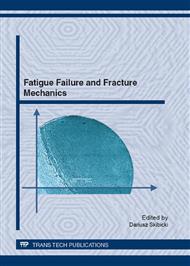p.11
p.17
p.27
p.33
p.39
p.43
p.51
p.55
p.63
Applying a Stepwise Load for Calculation of the S-N Curve for Trabecular Bone Based on the Linear Hypothesis for Fatigue Damage Accumulation
Abstract:
In this work were presented calculated fatigue curves based on fatigue tests of trabecular bone under stepwise load with the application of a linear hypothesis accumulation of fatigue damage. The investigation was performed on 61 cylindrical bone samples obtained from the neck of different femur heads. The bone sample fatigue tests were carried out under compression with stepwise increases of the applied load. The fatigue calculation assumed the Palmgren-Miner (P-M) linear hypothesis accumulation of fatigue damage and the associated modified formulae. The obtained mean fatigue curves were based on the modified stress σ/E0 (E0 – initial stiffnes) for the assumed rule-determined slope or y-intercept. The highest agreement with the literature was obtained for Σn/N=10.
Info:
Periodical:
Pages:
39-42
Citation:
Online since:
August 2012
Price:
Сopyright:
© 2012 Trans Tech Publications Ltd. All Rights Reserved
Share:
Citation:


